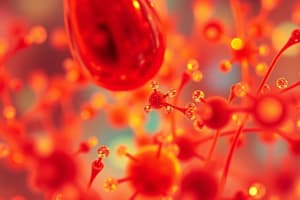Podcast
Questions and Answers
What is the definition of magnification in microscopy?
What is the definition of magnification in microscopy?
- The ratio of an object's image size to its real size. (correct)
- The ability to distinguish between two separate points.
- The clarity of the image produced.
- The visible differences in parts of the sample.
What is the primary purpose of staining specimens in light microscopy?
What is the primary purpose of staining specimens in light microscopy?
- To preserve live specimens for observation.
- To increase contrast between cell features. (correct)
- To enhance resolution.
- To improve the visibility of the background.
Which statement about light microscopes is true?
Which statement about light microscopes is true?
- They allow for the observation of living specimens without altering them.
- They can distinguish between two points only if the image is heavily stained.
- They require the use of chemical fixatives for all types of observations.
- Contrast can be achieved without staining a specimen. (correct)
In the context of light microscopy, what does resolution refer to?
In the context of light microscopy, what does resolution refer to?
What happens to cells during most staining procedures in light microscopy?
What happens to cells during most staining procedures in light microscopy?
Flashcards
Magnification
Magnification
The ratio of an object's image size to its real size. It makes an object appear larger.
Resolution
Resolution
The ability to distinguish between two separate points on an image. It determines the clarity of the image.
Contrast
Contrast
The visible differences in parts of a sample. It helps distinguish features from the background.
Brightfield Microscopy (Unstained)
Brightfield Microscopy (Unstained)
Signup and view all the flashcards
Brightfield Microscopy (Stained)
Brightfield Microscopy (Stained)
Signup and view all the flashcards
Study Notes
Light Microscopy
- Light microscopes use visible light that passes through a specimen and glass lenses.
- Lenses bend (refract) the light to magnify the image.
- Magnification is the ratio of the image's size to the real size of the object.
- Resolution is the clarity of the image, the ability to distinguish between separate points.
- Contrast is the visible difference between parts of the sample and the background.
Brightfield Microscopy (Unstained)
- Light directly passes through the specimen.
- Low contrast unless the cells are pigmented.
Brightfield Microscopy (Stained)
- Staining enhances contrast.
- Cells are fixed and stained (often killed in the process).
Studying That Suits You
Use AI to generate personalized quizzes and flashcards to suit your learning preferences.




